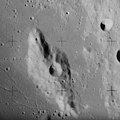 Lunar Orbiter 4 image Apollo 14 landing site is near center of top margin of image | |
| Coordinates | 6°00′S17°00′W / 6.0°S 17.0°W |
|---|---|
| Diameter | 95 km |
| Depth | None |
| Colongitude | 17° at sunrise |
| Eponym | Fra Mauro |

Fra Mauro is the worn remnant of a walled lunar plain. It is part of the surrounding Fra Mauro formation, being located to the northeast of Mare Cognitum and southeast of Mare Insularum. Attached to the southern rim are the co-joined craters Bonpland and Parry, which intrude into the formation forming inward-bulging walls. The crater is named after Italian geographer Fra Mauro. [1]






